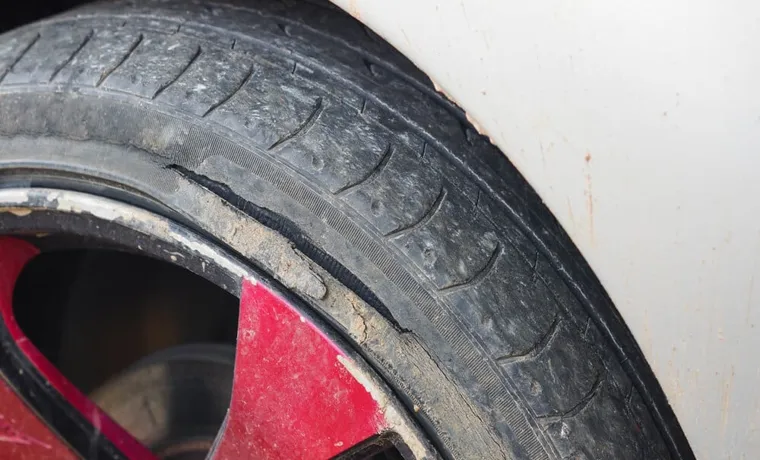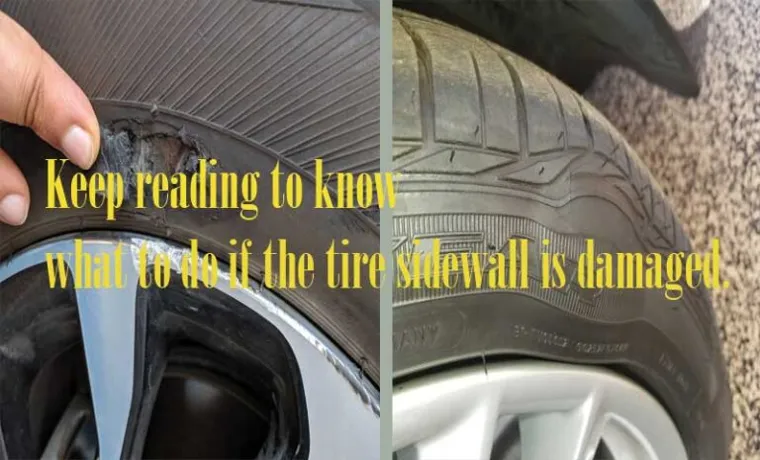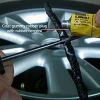Tire maintenance is an essential element in ensuring the safety of your vehicle. That’s why it’s crucial to know when to replace a tire’s sidewall damage to avoid any accidents on the road. While sidewall damage on tires can occur frequently, it’s important to note that not all of them require replacement.
Factors such as the severity of the damage, the type of tire, and the age of the tire should be considered in determining whether it’s time to replace a tire’s sidewall damage. So, how do you determine if it’s time to replace a damaged sidewall tire? In this blog, we will provide you with essential information on when to replace a tire’s sidewall damage to ensure the safety of your vehicle and everyone on the road.
Table of Contents
Understanding Sidewall Tire Damage
If you notice damage to your tire’s sidewall, it’s important to understand when it’s time for a replacement. Sidewall damage can come in many forms, such as cuts, punctures, or bulges. If you notice any of these issues, it’s best to have a professional take a look to determine if the tire can be repaired or if it needs to be replaced.
A puncture or cut in the sidewall, particularly if it’s deep, can compromise the tire’s structure and potentially cause a blowout. A bulge or blister on the sidewall is usually a sign of internal damage and can indicate that the tire is about to fail. In either case, continuing to drive on a damaged tire is a risk that’s not worth taking.
It’s important to address sidewall damage promptly and not put off a replacement. Driving on damaged tires can put you, your passengers, and other drivers on the road at risk. Keep a lookout for any damage on your tires, and if you notice any issues, don’t hesitate to have them inspected by a professional.
By doing so, you can ensure both your safety and the longevity of your vehicle.
Types of Sidewall Damage
Sidewall damage is one of the most common issues that car owners encounter. Understanding the different types of sidewall damage is crucial in ensuring your safety on the road. Sidewall tire damage can be caused by a variety of factors, including punctures, cuts, and scrapes to the rubber.
The most common types of sidewall damage include bulges, cuts, and punctures. A bulge can occur when the tire’s internal structure is damaged, causing a bulge to form on the sidewall. A cut is caused by sharp objects such as debris on the road, which can damage the tire’s rubber.
Punctures are caused by nails, screws, or other sharp objects piercing the tire’s rubber, allowing air to escape. It’s important to keep an eye out for any signs of sidewall damage and get it checked out as soon as possible by a professional. Ignoring sidewall damage can lead to tire failure, which can be extremely dangerous while driving.
Regular inspections and maintenance can help prevent sidewall damage and keep you safe on the road.

Signs of Sidewall Damage
Sidewall Damage or Sidewall Tire Damage Sidewall damage is a common issue that many car owners face. It occurs when the rubber sidewall of a tire becomes damaged. Some signs of sidewall damage include bulges, cuts, cracks, and punctures.
The damage can be caused by a variety of factors, including potholes, curbs, and debris on the road. If you notice any of these signs, it’s important to get your tires checked by a professional as soon as possible. Driving on a tire with sidewall damage can be dangerous, as it can lead to a blowout or other serious issues on the road.
To prevent sidewall damage, it’s important to take care of your tires. This includes regular maintenance, such as checking the air pressure and aligning the wheels. It’s also important to drive carefully, avoiding potholes and other road hazards to protect your tires from damage.
If you do notice sidewall damage, it’s essential to get it repaired or replaced right away to ensure your safety on the road. Ultimately, being aware of the signs of sidewall damage and taking the proper steps to prevent it can help you avoid costly repairs and keep you safe on the road.
Factors that Affect Sidewall Damage
Sidewall tire damage can be a serious issue for car owners and can potentially lead to dangerous situations on the road. There are several factors that can affect sidewall damage, such as the age of the tire, the type of tire, and the conditions in which the tire is used. As a general rule, it is recommended to replace a tire if it has any signs of sidewall damage as it can cause the tire to rapidly deflate, leading to a blowout or other accidents.
The main keyword “sidewall tire damage when to replace” is crucial to bear in mind when considering replacing the tire. It is essential to check the sidewalls of your tire regularly for any cracks, punctures, or bulges. These issues can be caused by many factors such as extreme temperatures, pot holes, or hitting the curb, so it is essential to keep an eye out for any signs of damage before it’s too late.
In summary, it’s critical to pay attention to any sidewall tire damage and take the necessary steps to replace your tire to ensure your safety on the road.
Tire Age and Wear
Tire Age and Wear – Factors that Affect Sidewall Damage One of the most important things to consider when it comes to tire maintenance is the age and wear of your tires. A tire’s sidewall is particularly vulnerable to damage, and there are a number of factors that can contribute to this. For example, extreme temperatures can cause a tire’s rubber to break down over time, making it more susceptible to punctures and other types of damage.
Additionally, driving on rough or uneven surfaces can increase the likelihood of sidewall damage, as can overloading your vehicle or failing to maintain proper tire pressure. To keep your tires in good condition and minimize the risk of sidewall damage, it’s important to inspect them regularly for signs of wear and aging and to replace them as needed. By taking these steps, you can help ensure that your tires remain safe and reliable, no matter where the road takes you.
Environmental Factors
Environmental factors play a significant role in the wear and tear of your vehicle’s tires, particularly the sidewalls. One of the primary environmental factors that can affect sidewall damage is extreme temperature changes. Rapidly fluctuating temperatures can cause the rubber in your tires to expand and contract, ultimately leading to cracks or bulges in the sidewall.
Additionally, exposure to sunlight and ozone can cause similar damage. Other environmental factors that can contribute to sidewall wear include exposure to salt or other harsh chemicals, driving on rough or uneven surfaces, and low tire pressure. It’s essential to take steps to adequately maintain your tires to prevent sidewall damage, including regularly checking tire pressure, avoiding rough roads, and protecting your tires from excessive sunlight and chemical exposure.
Keeping an eye on the condition of your sidewalls can help prevent dangerous blowouts and extend the lifespan of your tires.
When to Replace a Damaged Sidewall tire
If you’ve had a damaged sidewall tire, you may be wondering when you should replace it. The answer is simple – always replace a tire with sidewall damage. Sidewall damage can range from minor cuts and punctures to large tears and bulges, and all types of sidewall damage can cause serious safety concerns.
A sidewall tire damaged by a cut or puncture may not immediately deflate, but it can cause a very dangerous blowout while driving. Even if the tire seems to be holding up well, the integrity of the tire is compromised when the sidewall is damaged, and it should be replaced as soon as possible. Putting off replacing a damaged tire is not worth the risk of a potential accident.
Always prioritize safety and replace a tire with sidewall damage promptly.
Severity of the Damage
When determining if a damaged sidewall tire needs to be replaced, it’s essential to assess the severity of the damage. Minor cuts or scrapes on the sidewall can often be repaired, but larger punctures or cracks may require a full replacement. A damaged sidewall can compromise the integrity of the tire, leading to increased risks of blowouts or flats while driving.
Additionally, sidewall damage can make it difficult to maintain proper inflation levels, which can negatively impact fuel efficiency and contribute to uneven wear. If you notice any bulges, blisters or deformities on the sidewall of your vehicle’s tire, it’s wise to have it inspected by a professional to determine if replacement is necessary. While a new tire may be an investment, it’s worth prioritizing your safety on the road and avoiding potentially costly repairs down the line.
Location of the Damage on the Tire
When it comes to tire damage, the location of the damage can determine whether or not it’s safe to continue driving on the tire. Sidewall damage is a common problem that drivers may encounter, but it’s important to know when it’s time to replace the damaged tire. Sidewall damage can be caused by a variety of factors, including hitting curbs or potholes.
If the damage is located near the tread of the tire, it’s possible that the tire can still be used. However, if the damage is located closer to the edge of the tire or near the bead area, it’s likely that the tire will need to be replaced. Sidewall damage in these areas can compromise the structural integrity of the tire and increase the risk of a blowout while driving.
Always inspect any tire damage carefully and consult with a tire professional to determine the best course of action. Neglecting to replace a damaged tire can lead to dangerous driving conditions and the need for expensive repairs in the future.
Whether the Tire is a Summer or Winter Tire
When it comes to determining when to replace a damaged sidewall tire, consider the type of tire you have. If it’s a summer tire, its rubber compound is designed for warmer temperatures and will stiffen in colder weather, reducing traction and increasing the risk of skidding. In contrast, winter tires are made with a special rubber compound that stays softer in cold temperatures, providing better grip on snow and ice.
Regardless of the type of tire, any damage to the sidewall should be taken seriously and addressed promptly. A damaged sidewall can compromise the structural integrity of the tire and increase the risk of a blowout while driving. Signs of sidewall damage include bulging, cracking, and punctures.
If you notice any of these, it’s best to have the tire inspected by a professional and, if necessary, replaced. Remember, replacing a damaged tire sooner rather than later can save you from more costly repairs down the road and ensure your safety on the road.
Conclusion
In the world of tires, sidewall damage is like a ticking time bomb. It may look innocent and subtle at first, but any crack or puncture in the sidewall can weaken the whole structure and compromise your safety on the road. Don’t be fooled by the flashy treads or the brand name; always pay attention to the signs of damage and replace your tires promptly, or else you may end up with a flat tire, a blowout, or a costly repair bill.
Remember, a good tire is like a good friend- it supports you when you need it the most and never lets you down.”
FAQs
What exactly is sidewall tire damage?
Sidewall tire damage refers to any physical harm that occurs on the side of a tire.
How can I check for sidewall tire damage?
To check for sidewall tire damage, inspect the side of your tire for any cuts, bulges, cracks, or punctures.
Can I still use my tire if it has sidewall damage?
It is not recommended to use a tire with sidewall damage as it can be dangerous to drive on and can lead to a blowout.
How often should I check my tires for sidewall damage?
It is recommended to check your tires for sidewall damage at least once a month to ensure they are in good condition.
What causes sidewall tire damage?
Sidewall tire damage can be caused by a range of factors including road hazards, improper inflation, and normal wear and tear.
When should I replace my tire due to sidewall damage?
You should replace your tire immediately if there is severe sidewall damage (such as a large cut or bulge) or if a professional recommends it.
Can sidewall tire damage be repaired?
It is generally not recommended to repair sidewall tire damage as it can compromise the structural integrity of the tire. It is better to replace the tire instead.




